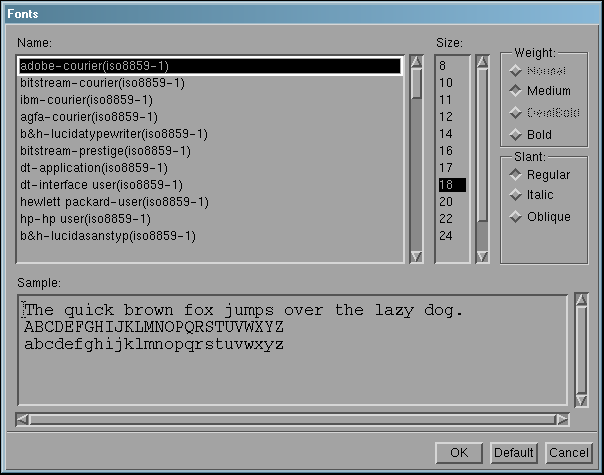Customizing Fonts in UNIX Environments
Difference between the System Font and Fonts That Are Used in the Windowing Environment
How SAS Determines Which Font to Use
If you did not specify
a value for the
SAS.DMSboldFont resource,
SAS uses the default normal font to determine the default bold font.
If the normal SAS.DMSFont has an XLFD
name associated with it, then SAS selects the matching bold font and
loads it. If SAS cannot automatically select or load a bold font,
the normal font is also used for the bold font.
Customizing Fonts by Using the Fonts Dialog Box
Specifying Font Resources
You can
customize the fonts that are used in the SAS windowing environment
with the following resources:
specifies the font
that you want to be used as the default normal font. The default normal
font is Courier.
specifies the multi-byte
normal character set font used by the SAS windowing system for operating
environments that support multi-byte character sets.
specifies the multi-byte
bold character set font used by the SAS windowing system for operating
environments that support multi-byte character sets.
specifies an X Logical
Font Description, or XLFD pattern that you want SAS to use to determine
the windowing environment font. Most fonts in the X Window System
are associated with an XLFD, which contains a number of different
fields delimited by a hyphen (–) character. The fields in
the XLFD indicate properties such as the font family name, weight,
size, resolution, and whether the font is proportional or monospaced.
Refer to your X Window System documentation for more information
about the XLFD and font names used with X.
The XLFD-pattern that you specify for
SAS.DMSfontPatternSAS.DMSFontPattern: -*-*-*-r-*--*-*-*-*-m-*-iso8859-1
-
SAS excludes all fonts that have X and Y resolution values different from the current X display, all fonts that have variable character cell sizing (such as proportional fonts), and all fonts that have point sizes smaller than 8 points or larger than 15 points. If this step results in an empty list, SAS chooses a generic (and usually fixed) font.
specifies an XLFD font
pattern that describes the candidate fonts used to resolve SAS graphics
font requests. Using this pattern allows the user to optimize or control
the use of X fonts within the context of various SAS graphics applications.
The default value of
* usually does not affect
performance to a significant degree. You might want to restrict the
font search if you are running SAS on a server with an excessive number
of fonts or that is operating in performance-limited environment.
specifies the system
font. The SAS font is used in SAS windows. The system font is used
in most dialog boxes and menus. SAS typically inherits the system
font from the font resources set by the X window environment, such
as the Common Desktop Environment (CDE), or K Desktop Environment
(KDE). If the
*.systemFont resource,
SAS uses a 12-point Helvetica font.
Specifying Font Aliases
Font Aliases
If your server does not provide fonts to match all of
the fonts that are supplied by SAS, you can use font alias resources
to substitute the fonts that are available on your system. (Ask your
system administrator about the fonts that are available.) Use the
following syntax to specify font aliases in your resource file:
SAS.supplied-fontAlias: substitute-familysupplied-font is the name of the font supplied by SAS. substitute-family is the family name of the font that you want to substitute.
CAUTION:
Do not
specify a SAS font as a font alias.
There might be a conflict
if you specify a font supplied by SAS as a font alias, as in the following
example:
SAS.timesRomanAlias: symbolAssigning this value to a font alias prevents the selection of any symbol fonts through the font selection dialog box, because they are specified as the Times Roman alias.
